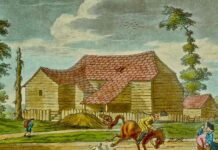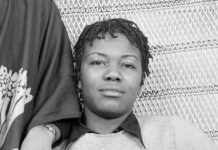Nick Buglione continues a journey through time with his recollections of Brixton – this month, the nineties
Au revoir the 1980s, bonjour Brixton 1990s. The party years, the hedonistic years, to reuse a dodgy phrase, the “ghetto fabulous” decade. Where our favourite slice of south London genuinely began its transformation from shabbily splendid isolation to today’s (eventual) post-hipster sub-metropolis. Except, for now, this was fuelled, not by London’s hysterically spiralling housing prices, but by social blooming, creative germination and … the Dogstar.
If I could stop time, this is where I would have stopped it. As a bubbling backwater of opportunity and some legendary parties not yet sanitisied and overwhelmingly gentrified by property prices and aspirational schooling manoeuvres.
In the (marketing) age of Brit-Pop, in between celebrating the second “summer of love” on the Fridge balcony and dancing on tables in the Dogstar, we indulgently mused that if, all of a sudden, Britain was at the apex of world cool, London was clearly the coolest. So by irrefutable logic, the coolest person in Brixton was the coolest person in the world.
Life centred round a social axis of The Dogstar, The Fridge, St Matthew’s Church, the Phoenix Café, Brockwell Lido and the all-singing, all-dancing new multi-screen “arthouse” multiplex The Ritzy. RIP the stoner all-nighters.
Brixton was a relatively small, mildly hip, ecosystem in which to be a relatively medium sized fish.
Tensions still existed for sure. There were riots after the death of Wayne Douglas in police custody, when the Dogstar was “windowed” and “torched” on the eve of “our” Circa Magazine party, and the horrific 1999 nail bomb, offset by glorious days such as Mandela pitching up at Brixton Rec to an inspiringly rapturous crowd.
The “Village” was still mostly a derelict potential palette for today’s foodie emporia, although Fujiyama was here to begin stretching the Brixton menu beyond fried chicken.
Circa Magazine was a Brixton mag launched by Sandie Tozer, where I cut my journalistic teeth. It steered clear of politics and the ups and downs of Lambeth council and talked about local celebs, interesting cultural happenings and Brixton’s semi-flourishing nightlife.
Let’s not get all “Warhol Factory”, but it was a bunch of enthusiastic, slightly sideways people creating something in enthusiastic semi-amateurish ways. Ahead of its time, nowadays it would be a crowdfunded website and a kickstarted app.
My first ever feature? An interview with Miranda Sawyer in the Lido Café, I suspect in swimming trunks. Today we are both middle-aged parents at the same school. With Circa’s pokey editorial offices housed first in the upper reaches of St Matthew’s Church and later in the chaotic upper rooms of the Dogstar where we also ran Lawrence Merritt’s Dogstar press operations.
The 1990s was also when the internet and mobiles arrived to change the world. All of a sudden, those images you were chasing weren’t arriving as transparencies by courier (or post!), they were flying through cyberspace with ten minutes to deadline. Backed by intermittent cellphone calls on huge brick-like phones with suspect network coverage. Ironic, as I am submitting this article with about 30 seconds to deadline. RIP the fax machine.
The Dogstar should be credited with practically inventing the now ubiquitous late night/all night pub-club and helping to transform Coldharbour Lane into a somewhat safer, less imposing after hours social boulevard. All of a sudden the international bright young things of Clapham and Putney sauntered down Coldharbour Lane at the weekends in search of DJs, late night hedonism and all kinds of intoxicants. Rubbing shoulders with old school still murky, occasionally troubled Brixton. Our private patch was suddenly socially significant, less of an exclusive island unto itself. I suspect we viewed the new bohemians with slightly inverse snobby amusement. They hadn’t done the hard miles.
While the Dogstar and the Fridge reigned at night, the daytime clubhouse was the Phoenix Café, where, without arrangement, we’d all congregate for steamy hangover cure fry-ups and lunchtime gossip. Gone but not forgotten.
While the Dogstar and the Fridge reigned at night, the daytime clubhouse was the Phoenix Café, where, without arrangement, we’d all congregate for steamy hangover cure fry-ups and lunchtime gossip. Gone but not forgotten.
And for a couple of glorious summers, the urban oasis that was Brockwell Lido was a home from home. Rescued from squatty semi-dereliction by two guys called Paddy Castledine and Casey McGlue, at least one long hot summer passed us by where a surprisingly small congregation of locals (with clearly too much leisure time on our hands) camped out there while the rest of the world remained blissfully ignorant it was even open. Imagine more or less having the whole place to yourself and a few others. Grab some pasties from Kennedy’s in Herne Hill, sneak in some beers, and stay for the day.
For want of a better word, the wonderfully dishevelled Alabama 3 were the house band of Brixton, fuelled by The Sopranos
opening credits, an heroic devotion to bourbon and the blues, debut magnum opus Exile on Coldharbour Lane and amazing live residencies at Mass in St Matthew’s Church. Where a saucer-eyed, highly fuelled, often dishevelled hedonistic Brixton Acid Posse were hosted by Larry Love and Reverend D Wayne Love. Spiritual HQ: Bradys. With themes of the October Revolution (where the whole band shaved their heads and came out as Lenin), embracing Elvis via diamante outfits and Vegas kitsch and a gospel night with a whole choir on stage, along with Soul II Soul, still Brixton’s greatest musical nights and their debut album has remained a vinyl favourite ever since.
We even hosted our own “white-boy” hip-hop nights at The Vox which was a club in the vaults of Brighton Terrace, chosen only as our limited retinue of guests were transported down to “A Bowl of Soul” via an industrial lift. We called ourselves the Doobie Funk Mellow, played too much Galliano and gradually realised we weren’t going to be the next club phenomenon.
As we started belatedly growing up, so too did Brixton.







…. and it might be worth removing your shroud of revisionist opinion for, as I recall, where we now have ‘bars and flash burger joints’ was once neo-derelict emptiness. It’s reverse apartheid to think that a ‘white middle class’ person – who thus cannot be black – is disqualified from saying something about their home. i agree, there is an argument for how the introduction of a vibrant retail and leisure zone should be brokered in terms of inclusivity, but it seems all you guys seem to do is believe anything other than the (partly) gloomy past is some sort of social crime. It’s pretty easy to find the number of Brixton Bugle/Blog articles I have done on ‘periods in Brixton’s past’ and ‘gentrification’ to understand what I have been saying and return with a potentially less dogmatic opinion.
Are you people actually reading the articles or just knee-jerkingly responding with a fixed agenda? Where do I laud flashy bars, where do I say the place I have lived in for almost 20 years is rubbish and did we miss the bit where I stated that the later decades of gentrification we’rent particularly my cup of tea?
Yes, there were middle class people around in Brixton then but there are and still is loads of black people. I like Bassnation am sick and tired of hearing about bars and flash burger joints which I personally think lack taste!! You write as if Brixton back then was rubbish. Can I tell you though, Brixton back then was a vibrant community which I loved thanks, The newbies presently trying to take over (as per usual) have turned Brixton into a boring, luck lustre place where all you see is vomit/pee and lager bottles on the pavements! I think if anyone has a blinkered view it is you……
That would be because I rarely went to a squat rave in the 90s and if you had read my 1980s article, you would see I referenced that (to a certain extent) there. Apart from a girlfriend who went to those huge dub nights at the rec, I am not a reggae man beyond a collection of Marley and Tosh albums. You seem to fail to see what the article is about – for better or worse – me! I can live with it being called drivel but in case you missed it with your predictably blinkered view on Brixton, there were middle class white people around. I write about something approaching my reality, not what is going to keep people with your opinion happy just to pass some ridiculous test. I would be interested in reading about squat raves and reggae so maybe stop whining and write something longer than a quick moan? Beyond that… I spare you
Nothing about the free party scene /’ squat raves. Nothing about reggae.
Just the usual white middle class drivel. Spare me.